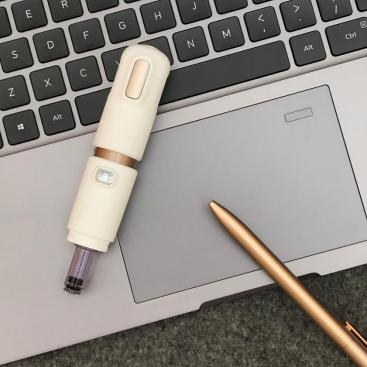Needle-freeinjectors are revolutionizing the administration of medications and vaccines, offering a painless and efficient alternative to traditional needle-based methods.This innovation is particularly significant in enhancing patient compliance, reducing the risk of needlestick injuries, and minimizing the anxiety associated with needle injections.This article delves into the engineering behind needle-free injectors and explores their clinical applications and benefits.
Engineering Aspects
Mechanism of Action
Needle-free injectors deliver medications through a high- speed jet of liquid, which penetrates the skin and deposits the drug into the underlying tissue.This method relies on three core components:
Energy Source: This can be a spring, compressed gas, or a piezoelectric element that generates the necessary force to create the jet stream.

Drug Reservoir: A chamber that holds the medication to be delivered.
Nozzle: A small orifice through which the drug is expelled at high velocity.
Types of Needle-Free Injectors
Spring-Loaded Injectors: These use a spring mechanism to generate the required pressure. When the spring is released, it propels the medication through the nozzle.
Gas-Powered Injectors: Utilize compressed gas, such as CO2, to create the high-speed jet needed for drug delivery.
Piezoelectric Injectors: Employ piezoelectric crystals that expand when an electric current is applied, generating the force to expel the medication.
Key Engineering Challenges
Jet Formation: Ensuring the jet is strong enough to penetrate the skin but not so forceful as to cause tissue damage.
Dosage Accuracy: Precise control over the amount of medication delivered with each injection.
Device Reliability: Consistent performance across multiple uses without failure.
MaterialSelection: Using biocompatible and durable materials to prevent reactions and ensure longevity.Clinical Aspects
Advantages Over Traditional Injections
Pain Reduction: The absence of a needle significantly reduces pain and discomfort.
Improved Patient Compliance: Particularly beneficial for pediatric and needle-phobic patients.
Lower Risk of Needlestick Injuries: Reduces the hazard for healthcare workers.
Enhanced Safety: Minimizes the risk of cross-contamination and infection.
Applications
Vaccinations: Effective in administering vaccines, including those for influenza, measles, and COVID-19.
Insulin Delivery: Used by diabetic patients to administer insulin without the need for daily needle pricks.
Local Anesthesia: Employed in dental and minor surgical procedures to deliver anesthetics.
Growth Hormone Therapy: Utilized for administering growth hormones, particularly in pediatric patients.
Clinical Efficacy
Studies have shown that needle-free injectors can achieve comparable, if not superior, pharmacokinetic profiles to traditional needle injections.For instance, in insulin delivery, these devices have demonstrated equivalent glycemic control with improved patient satisfaction.Similarly, needle-free vaccination has been found to elicit robust immune responses.
Challenges and Considerations
Cost: Higher initial costs compared to conventional syringes, though this may be offset by long-term benefits.Training: Healthcare providers and patients require proper training to use the devices effectively.
Device Compatibility: Not all medications are suitable for needle-free delivery due to viscosity or dosage form.Skin Variability: Differences in skin thickness and texture among patients can affect the injection's efficacy.
Future Directions
Advancements in microfabrication and materials science are expected to further refine needle-free injector technology.Innovations such as smart injectors, capable of monitoring and adjusting dosage in real-time, are on the horizon.Additionally, research into broader applications, including biologics and gene therapies, holds promise for expanding the utility of these devices.
Needle-free injectors represent a significant leap forward in medical technology, offering numerous benefits over traditional needle-based methods.While there are challenges to overcome, the clinical and engineering advancements in this field continue to pave the way for more efficient, safer, and patient-friendly drug delivery systems.As technology progresses, needle-free injectors are poised to become a staple in modern medicine, transforming the landscape of therapeutic administration.
Post time: Jul-29-2024
